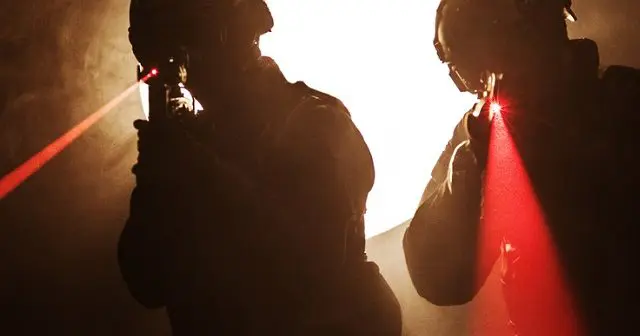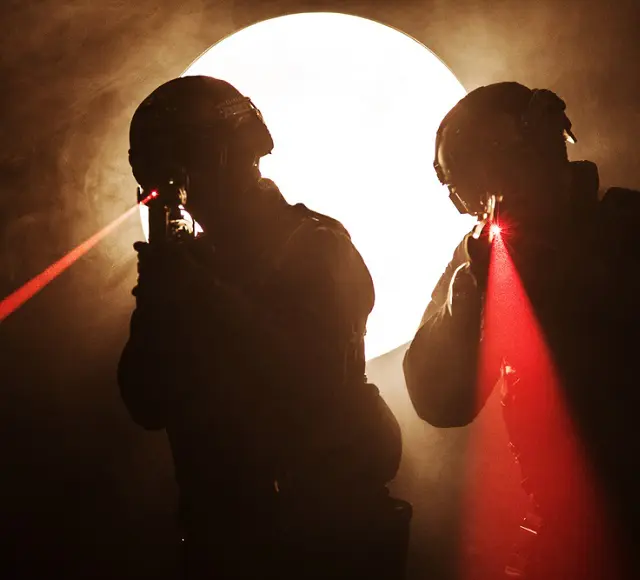
INTRODUCTION
By the end of 2021, a viable Laser Pistol designed to Burn-Through Human flesh at distance will be likely achievable, given its current rate of technological convergence and development. The notion of a Laser Pistol, began at the turn of the 20th Century, as a trope, and plot device in science-fiction novelization, and comic books. Within a lifetime, it has gone from a mail-order novelty (circa mid-1960s); a toy (late-1970s); a leisure and military training aid (the 1980s); and, a sporting target weapon in the early

“Roy Davis Laboratory Laser Pistol Plans and Instructions (Circa 1966).”
21st Century. Merged with industrial-use cutting Lasers developments, the Laser Pistol represents a new family of weapons. This new weapon’s family have potential to replace the existing family of conventional kinetic weapons, that rely on chemical propellant projectiles: the Conventional Firearms, that have dominated the battlefield for several centuries, that began with the gunpowder revolution. This paper will look at Laser Pistol development in terms of technology, weapon characteristics, novel tactics, and future uses.
THE LASER BATTLEFIELD
This paper aims to describe what a battlefield would look like conducted with a new family of Human portable powerful burning Laser Weapon Devices: Laser Pistols, configured to be used like conventional small arms (see FIGURE 1).
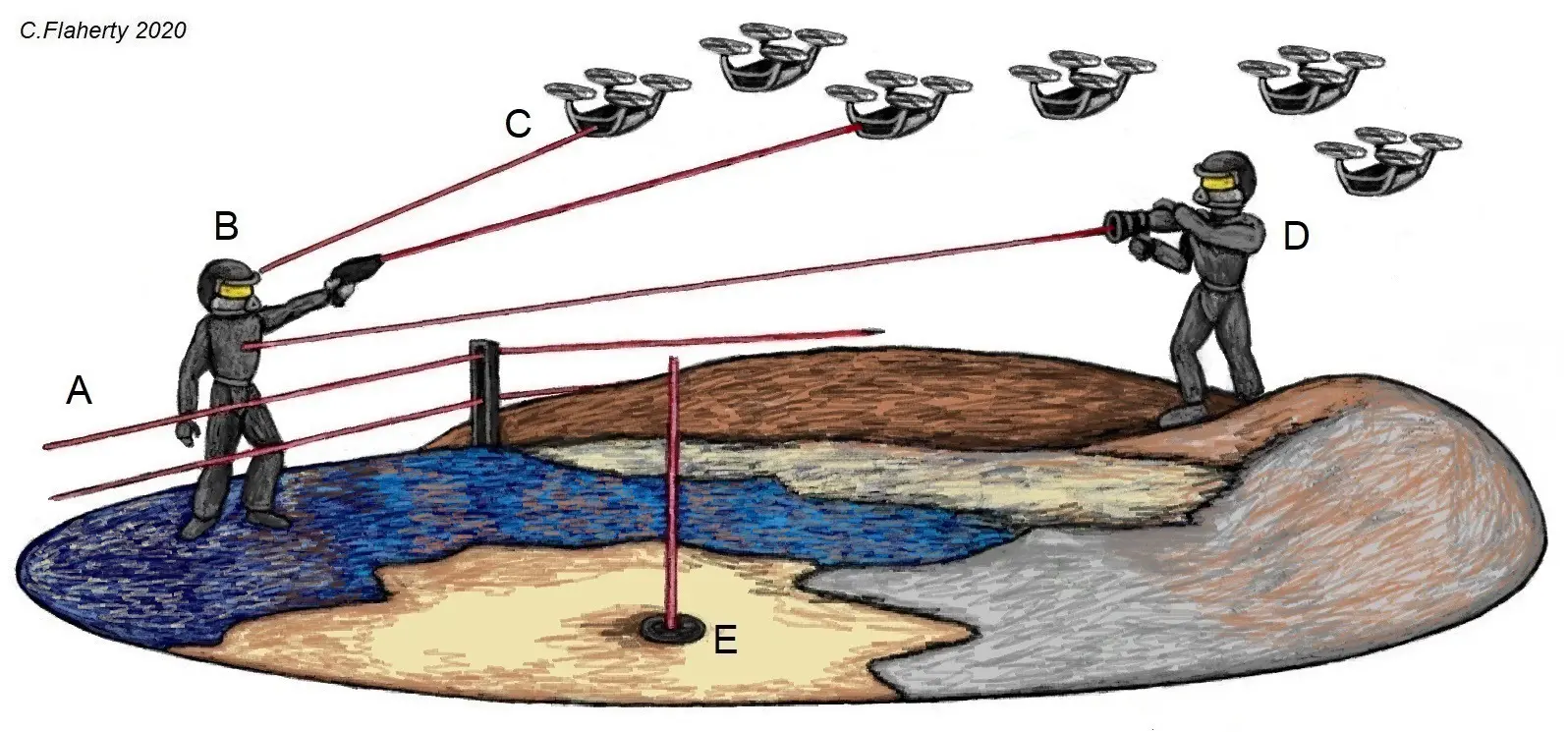
“FIGURE 1: Illustrates the laser battlefield showing: (A) Laser Fence; (B) Enemy combatant fires a Laser Pistol targeting a flying drone; (C) Swarming drone fires its Laser weapon at an enemy combatant; (D) Defending combatant uses a Laserarm; and, (E) A Laser Mine is fired.”
FIGURE 1 (B-D): Illustrates two combatants on the laser battlefield, one uses a Laser Pistol (B), the other combatant uses a Laser Rifle (D). However, this is not a true rifle (in the conventional sense), it is the same technology as the Laser Pistol, configured to look like a rifle weapon, using the shoulder butt to achieve greater laser weapon stability, to increase the Dwell-Time on a target to achieve a Burn-Through.
The purpose of the paper is to explore novel tactics that arise from the characteristics of Laser Pistol (as these are defined by the current technologies used to create a Laser Beam). As a basic military proposition, “Lasers have long been recognized … as a potentially more desirable form of weaponry than conventional arms.” (Anderberg, 1992; Lindsay, 1998; Bunker, 2000a) The point of departure is the observation:
“Lasers do not represent some sort of ‘notional or what if’ threat but already exists in real world Counter-Optical and vision disrupting concern for the U.S. military services and for some governmental and Law Enforcement Agencies” (Bunker, 2008).
Three key propositions can be identified comparing the weapon called, the ‘Laserarm – handheld laser weapon’ (Bunker, 1999; 2000; 2008a), to the Conventional Firearm:
- Treating the Laserarm as if it is a Conventional Firearm
One of the key conceptual errors being made in current thinking about the use of a Laser Pistol is treating the weapon as if it is a Conventional Firearm, seeing it as a direct replacement rather than a route to novel tactics. The enduring tactical qualities of a Laser Pistol, as opposed to the Conventional Firearm, is that a Laser travels in a near straight line trajectory, and where it is a continuous Bean, it has a variety of effects over the length of its Path (its end-point is where that Beam begins to scatter losing power). Whereas the line-of-sight aiming of a Laser Pistol is identical to its Beam-Path, a projectile-bullet fired from a Conventional Firearm travels in an arc. The time of flight,
“[is]… one of the most significant advantages of Lasers … unlike a rifle bullet, a Laser Beam strikes the intended target immediately because it is travelling at the speed of light … instead of in ranges at or near the speed of sound.” (Lindsay, 1998; Bunker, 2000a)
The comparison between how a Laser Pistol works, and a Conventional Firearm, can be seen where the two are combined. For instance, comparing the ‘red spot’ made by a Laser sight fitted to a rifle, and the final point-of-impact of its projectile-bullet when it is fired. The riflemen is required to aim their gun, calculating as the bullet starts dropping it will have its correct point-of-impact at a certain range. Effectively there is an adjustment distance between the Laser ‘red spot’ (which in the case of a Laser Pistol would be its point-of-impact), and that made by a projectile-bullet fired from a Conventional Firearm.
- The Shift from Weapons Causing a Penetrative Wound
As a broad proposition, Humans are psychologically wired to see blood as threatening. As a prejudice – blood fixation, prefigures much of how we conceptualize a weapon’s function; being its primary function to achieve a penetrative wound. Seeing the Laser Pistol as the direct replacement for the Conventional Firearm, emphasising its capacity to Burn-Through a target, as the functional equivalent of the penetration by a fired projectile, largely misses several other lethal weapon’s characteristic of a Laser Pistol, such as:
“a Laser need not kill or would … in the traditional sense of putting holes in … [a Human target]… with inert matter … or with the direct energy Beam of a High-Energy Laser … [rather a Low-Energy]… Laser … is sufficient to instead target the eyes.” (Lindsay, 1998; Bunker, 2000a)
Since the 1980s, the earliest fears was the use of Laser to cause blindness as a means to destroy another combatant (which is discussed later in this paper). The Laser Pistol may also create a new category of internal injury, through built-up of heat within a body; leading to new forms of battlefield casualties, which will require new types of medical response (Bunker, 2000). The medical and psychological aspects of Laser injury are overviewed at the end of this paper.
- The Geneva Convention Ban
The international ban on Laser weapons which can cause permanent blindness are based on a 30 July, 1998 ratified protocol which is part of the 1980 U.N. Convention on Conventional Weapons (Geneva Convention, 1980; Bunker, 2000a). There is also an earlier 1995 U.S. Department of Defence policy on Blinding Lasers, that:
“prohibits the use of Lasers specifically designed to cause permanent blindness of unenhanced vision and supports negotiations prohibiting the use of such weapons.” (U.S. Government, 1995)
A critical complaint about the Geneva Convention ban namely, “[it]… does not cover inadvertent human blindness caused by systems designed to disable sensors.” (Roblin, 2018) For instance, current In-Service powerful Laser Dazzlers, used to disable Laser range finders and target designators of battlefield opponents, the Beam power (the Wavelength of these weapons), is such that it could cause blindness to opposing Human combatants caught in the Beam-Path (this issue is discussed further, later in this paper).
TECHNOLOGICAL TRANSITION
The Laser Pistol represents a new type of lethality, combining several novel tactical qualities. It hits its target instantaneously. If the Laser components used do not produce a coloured Beam, this is likely invisible (as its Wavelength is outside the range of Human visibility), and the Laser Pistol will not emit any sound when fired. Harnessing tactical factors: invisibility, silence, and instantaneous Burn-Through could dramatically favour attackers. It has a near straight trajectory; however, its range is a limitation caused by Beam Divergence. Along its Beam it can have three effects at certain Wavelength (discussed later in this paper), namely: (1) Burn-Through, (2) Blind, and (3) Dazzle its target.
The beginnings of the Laser Pistol in the 1990s, was the Laser Pointer:
“one of a number of military follow-on technologies to firearms. They will probably be one of the first Law Enforcement will have to contend with domestically, for both defensive and offensive purposes. Laser Pointers represent harbingers of some of the small arms to come based on direct energy.” (Bunker, 1999)
Dubbed the, “Common Laserarm” (Bunker, 1999; 2000), this was a hand-held tubular device with a cable connected to a battery box. Its use was to create Counter-Optical Tactics (Bunker, 2000). One of the earliest differences identified, comparing powerful Lasers falling into Class 3B (Medium) and Class 4 (High to Severe Eye Injury) classifications with Conventional Firearms, was the:
“effective ranges measured in hundreds and, in some cases thousands, of meters which makes them superior in range to most firearms employed by tactical officers.” (Bunker, 2000)
From a tactical perspective, the Laser Pistol is a Deep-Penetration weapon, that can have enfilading effects along the entire length of its Beam-Path. The ultimate development of the Laser Pistol is combining two key specifications: (1) a powerful Burn-Through Laser; and, (2) the strongest human-portable (handheld) weapon. However, early on, the technology split into two types a weapons, and corresponding tactics, the Burn-Through Laser Pistols, and the Laser Pistol Dazzlers, and Blinders (discussed later in this paper).
Homemade Laser Pistol
The Laserarm began as an improper use of an off-the-shelf commercial Laser, the next point in transition was the “Improvised Laser Weapon” (Bunker, 2008). The next development was Grey (Military-Like Technology), where a Laser weapon was assembled by Terrorists from various componentry. In this paper it is argued the next stage is the ‘Homemade Laser Pistol’. Historically speaking three broad development periods can be identified for the Laser Pistol, since 2000, beginning with off-the-shelf Laser Pointers proliferation (see FIGURE 2).
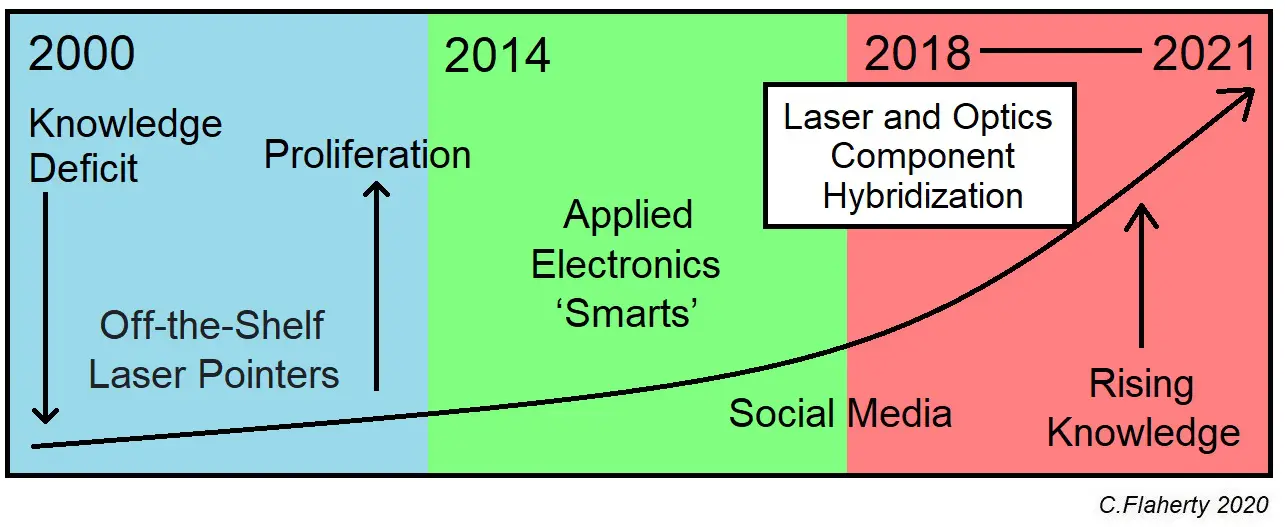
“FIGURE 2: Laserarms to Laser Pistols technological and knowledge transition from 2000 till 2021.”
FIGURE 2: Shows a model of the technological shift and knowledge transition from Laserarms to Laser Pistols, from 2000 till 2021. Beginning with off-the-shelf Laser Pointers (Laserarms) proliferation, these were being used by assailants with little in the way of tactical ‘smarts’, or real knowledge about Lasers, and were largely being used as an extension of bullying, harassment, and intimidation (fear-making) social strategies, that also saw the beginnings of Counter-Optics Tactics (Bunker, 1999; 2000).
Towards the end of the decade, a growing knowledge field of Applied Electronics ‘smarts’ begins a technological process towards Laser and Optics Component Hybridization, creating an actual Laser Pistol. The next step beyond that, is the role of social media in promulgating (as it has been doing with the creation of Laser Technology Knowledge), with greater Tactic ‘smarts’ in how to effectively use a Laser Pistol. Currently, something of a Homemade Laser Pistol arms-race is occurring. Designers-creators-influencers are challenging each other to create more powerful handheld Laser Pistols, with greater Burn-Through ranges.
A parallel development, has been a shift from Laserarms sitting within specific classifications, to a Laser Pistol having a multi-range of characteristics and classifications. The Laserarm originally sat within a specified set of Classes 3B, and 4 (discussed above). Originally, the Laserarms (that were in effect off-the-shelf commercial Laser Pointers being used for wrongful purposes), were quickly recognized as effective for use in Counter-Optics Tactics, by criminals and terrorists. Laser and optics component hybridization, however, creates a Laser Pistol that operates over multiple classifications, it can be a Burn-Through class of weapon, and be a Counter-Optics Tactics weapon at the same time, creating new novel tactics.
Several YouTube posts show computer aided design: 3D-Modelling Software, and 3D-Printing used to design a handheld pistol converted from a commercial Laser engraver (YouTube, 2017). Other versions are known on YouTube converting a variety of commercial powerful Continuous Wave Laser components, such as stripped-down Laser Projectors, and Laser Surgery Units into firearm equivalents (YouTube, 2020). Many demonstrate limited Burn-Through ranges (1.5 meters: 4.9 feet); however, beyond that range the same Beam has capacity to cause eye injury (Blindness), and temporary blinding effects: Dazzling (see FIGURE 3).
The continuing trend in Counter Optical Tactics – even the Purposeful Blinding tactical variation (discussed later in this paper), has seen Laser Pointers (Pens), and Internet purchased Higher-Powered Green Laser Pointers used to attack Riot Police. Technology convergence, higher battery power, efficiency and miniaturisation, greater access to Laser componentry, and promulgation of technology knowledge, and Laser weapons knowledge proliferation is largely due to the massive upswing in Social Media activity in the last decade, “the Internet allows information on new technology developments to be broadcast throughout the globe in days, if not hours.” (Bunker, 2008) Popularising Laser Pistols in television science fiction governmental, and crime dramas gives further impetus to the phenomenon.
DYNAMIC TACTICS
FIGURE 3: Shows a set of Laser Pistol dynamic tactics: Deep-Penetration Varied Effects Tactic. The Laser Pistol makes it possible to combine two different weapon’s tactics simultaneously: (1) putting an area under fire; and (2) aimed-fire at particular targets. Ease of line-of-sight aiming (Bunker, 2008), allows a major tactical change, namely a shift from centre-mass aiming to head-shots, and head-height firing. It can be viewed as a type of Deep-Penetration fire based on a tactical model extending the ‘Skid-Raking’ notion:
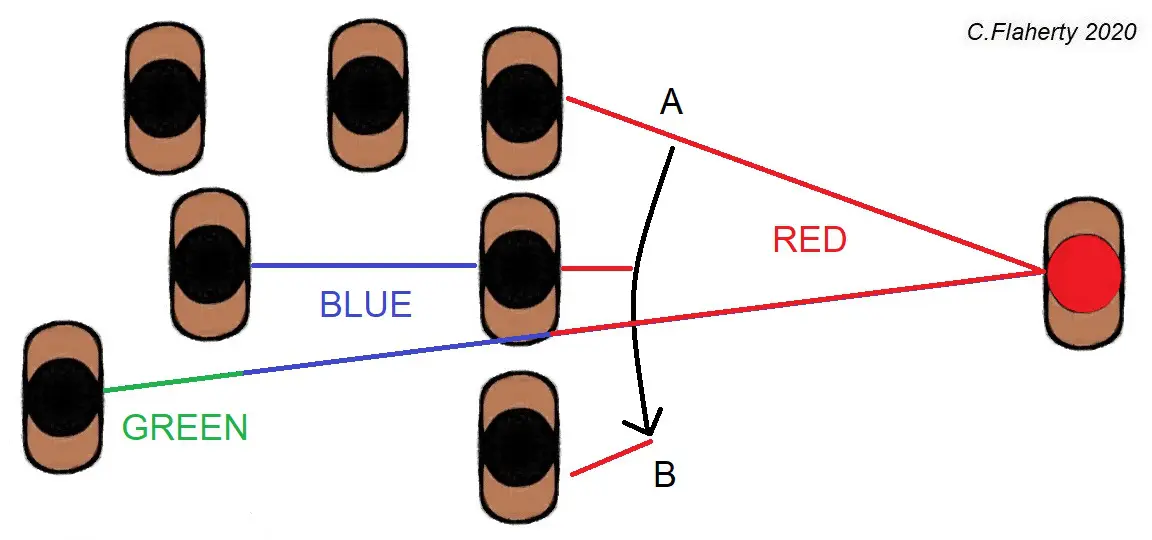
“FIGURE 3: The Deep-Penetration Varied Effects Tactic.”
“Tactical officer teams riding on the skids of a helicopter in preparation for an assault are highly vulnerable to a Counter-Optical Laser strike. A skid rake is to use a Laserarm in a raking motion against the assault team causing eye disruption and damage to the personnel.” (Bunker, 2000)
The Laser Pistol Beam can be sustained for longer periods, as long as its energy supply lasts. While having a diminishing point, where the Beam Divergence has a reduced effect on a more distant target; its Bean-Path might have sufficient intensity to spill over at greater distances cause eye-damage (Blinding and Dazzling), leading to a new tactical concept of Deep-Penetration Varied Effects. Effectively, the same Beam could effect a type of enfilade, where a series of targets, one behind the other are effected in varied ways.
The dynamic range of a Laser Pistol operates along its same continuous Beam, with three varied effects: Dazzling (Green), at its maximum effective range; Blinding (Blue) at its mid-length; and, Burn-Through (Red), at its point-plank range. Taking tactical advantage from the fact that a Beam-Path can have an energy spill-over, from the immediate target, potentially causing collateral damage wherever the energy extends (Spencer, 2020). A Beam operated continuously can be used to sweep along a linear formation, at the same time achieving Deep Formation Penetration. Taking advantage of Laser fire’s straight trajectory, its instantaneous hitting of a target at the speed of light, it can hit multiple targets almost instantaneously as the Beam is moved by the operator along a formation frontage (see FIGURE 3: A-B). It can be anticipated that a new category of Laser Pistol marksmanship, and skill based on the handler’s artful knowledge and application of the weapon’s capabilities are created. For instance, the operator sacrifices effective Burn-Through, by keeping the weapon pointed at a target for its sufficient Dell-Time, in favour of causing more limited, but likely just as effective in breaking up an attacking formation, through massive eye injuries caused to most if not all in the advancing formation. The notion of shooting at a target is redefined from its roots in a penetrative projective wound (causing incapacity or death), which has been the basis of human warfare since its pre-history origins, to tactics based on achieving gross-incapacity such as the mass-blinding of opponent formations (which will be discussed later in this paper).
THE EXTENDED LASER WEAPON FAMILY
While the primary focus of this paper is the Laser Pistol, it is worthy to note that the same technology translates into other weapons-tactical options, such as: Laser Fences, Small Flying Laser Pistol Drones, and Laser Mines. These could be examples of a new extended family of Laser weapons anticipated to dominate the future battlefield, with novel tactics.
The Laser Fence (FIGURE 1:A): Is used to destroy approaching enemy combatants. Largely an extension of the Laser Fencing System installed on the India-Pakistan Border (LASTEC, 2020). This could create a situation where battles are dominated by a fenced-line cutting-off one army from the other. This type of scenario has been a popular trope in early science-fiction, and it is largely based on using the near-straight trajectory of a Laser as somewhat akin to the wire-strands of boundary fencing. Far-forward placing of linear obstacles before a prepared killing field, has been a mainstay of 20th Century conventional warfare. A Laser Beam-Path leads to a battlefield geometry based on straight-lines. Laser Fences potentially set up a vertical killing zone. Providing the first line of defence where an opposing force is likely to operate strategically on the offensive, but tactically on the defence. Awaiting an attack anticipated to be swarming masses of human piloted, and robotic vehicles. Surviving attackers would then be engaged with a number of positioned Laser Weapon Devices.
Small Flying Laser Pistol Drone (FIGURE 1:C): These operate in swarms. Building a Laser Pistol into the drone is an extension of the current practice of mounting Conventional Firearms on drones. The notion illustrates a radical departure from conventional thinking that a Laser pistol needs to somehow replicate the Conventional Firearm directly. It can be effectively built into any electronic system, device, or other machine as an integrated part of it. A Small Flying Laser Pistol Drone could be remotely controlled by a combatant, with the controls built into their protective helmet, and the system could be the combatant’s main weapon.
Laser Mine (FIGURE 1:E): Replacing conventional anti-personnel mines, this could be a laser that fires an intense short-range beam up-through its target, such as the enemy combatant stepping onto the device and triggering it. This illustration is intended to show a novel concept replacing the explosive component with a powerful short-range Burn-Through Beam fired directly upwards when the device is triggered in the same way that any conventional land mine would be initiated.
Novel concepts such as the Laser Fence, Small Flying Laser Pistol Drones, and Laser Mines are simply notional constructs, that serve to illustrate the wide diversity of application that essentially the same Laser weapon technology can be applied to achieve a lethal event.
THE LASER PISTOL HISTORY
The concept of a Laser Pistol is relatively new, and began in the early 20th Century as a science-fiction trope, and prop. The Ray Gun, is largely the historical progenitor, and arose in its literary guise around 1917 (Rousseau, 1917; Clute, 2020).
Among the first signs of the Laser Pistol as a weapon design, was in publications like Popular Science, around circa 1966-67. The Roy Davis Laboratory, of Clove Spring, Florida, offered a mail-order set of How-to-Make instructions for $2, and a course on Lasers for $4.95 (the catalogue was an extra 50c).
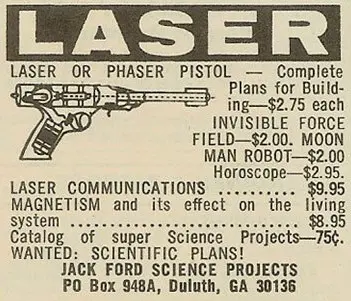
“A Roy Davis Laboratory Laser Pistol Advert (Circa 1966).”
Star Wars (1977), and Star Trek: The Motion Picture (1979), saw the first marketing of toy company laser (infrared beam) pistols. These pistols developed to the point, circa 1982-84, for Laser Tag arena games to be set-up. However, at an earlier date, the U.S. Army’s Multiple Integrated Laser Engagement System (MILES), had already been established, as a force-on-force training capability at home stations and combat training centers during operational testing in 1978 and 1979. This followed the conclusion of the U.S. Army’s Engineering Development program awarded to Xerox Electro-Optical Systems.
The Soviets around 1984, developed a Laser Pistol that used a lamp-cartridge loaded pyrotechnic flash, with a blinding force up to a range of 20 meters (65 feet). Intended for use by Cosmonauts in hand-to-hand fighting in Space (Zak, 2018).
The Chinese ZM-87 (a North Korean version is also known to have existed), is said to have been first fielded in the early 1990s (Federation of American Scientists, 1998; Bunker. 2008; Roblin, 2018). The ZM-87 Portable Laser Disturber, developed by Norinco (China Ordnance Industries Group Corporation Limited), was first displayed at the International Defense Exhibitions in the Philippines and the United Arab Emirates, in 1995 (Federation of American Scientists, 1998; Roblin, 2018).
As noted earlier in this paper, around 1999, till 2008, policing and security agencies were raising the alarm about the development, and proliferation of Laser Pointer technology. It was concluded the Laser Pointer presented a major threat to the military, and Law Enforcement, namely its ability to cause eye damage, and blindness.
The 2012 Olympics pistol shot portion of the Pentathlon was undertaken with Laser Pistols. Klaus Schormann, president of the International Union of Modern Pentathlon, “decreed Lasers are the future.” (Wasef, 2012)
The Current Laser Pistol
Transition from the Conventional Firearm to the Laserarm, is an historical process of technological transformation:
“It is projected that an incremental process will unfold over the course of many decades as Lasers, and other forms of directed energy weapons, emerge haphazardly as components that will augment firearms (e.g., Laser sights) and also be fielded as stand-alone systems both complementing and challenging firearms.” (Bunker, 2008a)
The rise of a handheld Laser weapon capability (Bunker, 2008a), has largely been seen as a far-off trend, likely taking place over several decades. However, more current developments have short-cut the process. Around 2018, Laser Pistols configured to give the appearance of rifles, or submachine-guns, like the Chinese ZKZM-500, made an appearance. Made by the Xian Institute of Optics and Precision Mechanics, in Shaanxi Province (also attributed to the Chengdu Hengan Police Equipment Manufacturing Company), the weapon has a rifle-like appearance with a stub-nose barrel end (Trevithick, 2018; South China Morning Post, 2018; Lin, 2018).
The Chinese ZKZM-500 YouTube video demonstrates its Burn-Through range on a crudely set-up building rooftop target, which is likely at an estimated distance of 150 feet: 45.7 meters from the firing-line. However, in the YouTube video the range is stated as some, “several hundred meters … [half a mile]” (South China Morning Post, 2018). News reporting described the weapon as a 15mm calibre, weighing 3 kilograms: 6.5 pounds, about the same weight as the standard Russian AK-47 Assault Rifle, with a range of 800 meters: 2,624 feet (Chen, 2018). It should be noted that some of the statements about this weapon such is its weight, calibre, and capabilities were miss-reported. It appears likely that the ZKZM-500 falls into a category of Infrared spectrum Lasers Pistols Counter-Optical Dazzlers (discussed later in this paper).
A 2018 YouTube video shows a Homemade Laser Pistol-Rifle with a tripod mounting, to increase weapon stability, to allow a sufficient Dwell-Time to explode a balloon at 60 feet: 18.2 meters (YouTube, 2018). The same video observed that 30 feet: 9.1 meters is about the maximum distance to Burn-Through with a handheld Laser Pistol. In this particular example, the Laser component (a Laser Diode) has been rehoused into an U.S. M16 -styled grip and butt assembly. The largest (bulkiest) part is a telescope component using a series of adjustable lens to act as a Laser Beam Expander. It should be noted that the live fire demonstration at greater ranges – 100 feet: 30.4 meters, appear to demonstrate a Dwell-Time that was apparently fractional: None (Nano-Seconds) -in time difference between ‘pulling the trigger’ and a point-of-impact (the balloon bursting). This is consistent with one of the enhanced tactical characteristics possessed by Lasers:
“[travelling at the speed of light]… no time of flight exists for it to hit a target. As soon as the trigger of the Laser weapon is pulled, the target has been engaged.” (Bunker, 2008a)
However, at greater distances of 150 feet: 45.7 meters, an apparent time-delay is noticeable between ‘pulling the trigger’ and the balloon bursting, as a greater Dwell-Time is required. This implies a tactical use, where a tripod mounting its used for more distant targets, and the combatant is in a static position.
Laser Pistol Counter-Optical Dazzlers and Blinding Weapons
Laser Pistols designed as Counter-Optics Dazzlers and Blinding weapons, rely on the, “unique properties of Lasers play … in their effect on the eye.” (Begert, 2008) The better documented class of In-Service weapons is a series of Chinese Counter-Optical Dazzlers and Blinding weapons, these are the ZM-87, the ZKZM-500 (discussed above), and the following rest of the series:
| TYPE | WEAPON WEIGHT | MAXIMUM RANGE | ||
| WJG-2002 Laser Dazzler | 5 kilograms | 11 pounds | 200 meters | 656 feet |
| BBQ-905 Laser Dazzler | 5 kilograms | 11 pounds | 1,000 meters | 3,280 feet |
| PY131A Blinding Laser Weapon | 6.4 kilograms | 14 pounds | 400 meters | 1,312 feet |
| PY132A Blinding Laser Weapon | 6.5 kilograms | 14 pounds | 400 meters | 1,312 feet |
| A1201 Laser Small Arm | Submachine-Gun Sized | – NOT KNOWN – | ||
| New Non-Lethal Laser Small Arm | – NOT KNOWN – | – NOT KNOWN – | ||
Sources: Global Security; UAVDACH, 2020.
All that is apparently known about the Chinese ‘New Non-Lethal Laser’ small arm, “[Is this] … uses an eight-kilowatt short-pulse beam to incapacitate targeted individuals by briefly heating surface of their skin to 500 degrees Celsius, causing intense, paralyzing pain.” (Roblin, 2018)
The physical appearance of the Chinese Laserarms all strongly resemble Conventional Firearms (Yao, 2015). For instance, the WJG-2002 Laser Dazzler was designed with a strong resemblance to the Chinese Army’s QBZ-95: Standard Bullpup Type 95 Assault Rifle, and likewise the BBQ-905 has a distinct assault rifle appearance. The likely explanation for this was to give the weapon a certain amount of camouflaging – disguising it in plain sight, so to speak,
“blend in with standard infantry weapons recalls the Soviet ROKS flamethrowers, designed to resemble a bolt-action rifle so as not to draw attention, down to having a wooden exterior.” (Roblin, 2018)
It has also been speculated the design is, “likely to both make it easier for troops to carry and to make it less likely for enemy forces to quickly isolate an individual carrying the system and focus their fire on them.” (Trevithick, 2018)
Comparatively, the PY131A and PY132A are described as bazooka-like weapons (Roblin, 2018). The main difference is the front of the weapon opens-up to a wide lens. Whereas the WJG-2002, and BBQ-905 have more the appearance of a wide-gauge stubbed barrel end. This feature likely gave rise to the misnomer description given to the ZKZM-500 that it had a 15mm calibre. The function of the wide lens end to the PY131A and PY132A, and the same fitting is depicted on a photograph of a version of the ZKZM-500, which is attributed to the Chengdu Hengan Police Equipment Manufacturing Company (Trevithick, 2018), may be a Telescope Laser Beam Expander component (discussed earlier).
LASER PISTOL WAVELENGTH CLASSIFICATION
| FIGURE 3: In this paper a simple tactical model has been used to describe three varied effects along the length of the same continuous Laser Beam-Path: Dazzling (Green), at its maximum effective range; Blinding (Blue) at its mid-length; and, Burn-Through (Red), at its point-plank range. However, in terms of classifying a Laser Pistol the real question is the Wavelength of its Beam. | BURN-THROUGH
|
| BLIND
| |
| DAZZLE
|
Problematically, there is little consistent agreement as to how to define a Laser Weapon, let alone a Laser Pistol, and a U.S. Department of Defence ratings scale that categorises and defines different levels of Laser damage effects is not widely accepted as a standard reference (Spencer, 2020). Broadly speaking the Wavelength is the specific colour of the Laser. This is colour-coded from Blue colour, Green, and Red portion of the visible spectrum of the Human eye. At the far-end of the Red spectrum: the Infrared portion of the spectrum, this is a type of radiant energy that is invisible to Human eyes, but can be felt as heat.
The 2018 Chinese ZKZM-500, discussed earlier fired an essentially invisible Beam: making it one operating at the Infrared portion of the spectrum, and invisible to Human eyes, and was demonstrated burning at a distance cardboard, nylon fabric and a rubber car tire. Human flesh is not burnt; However, an Infrared Beam can destroy a Human eye. Comparatively, a 2018 YouTube video shows a Homemade Laser Pistol-Rifle (discussed earlier), made with a Blue spectrum Laser Diode that was used to produce a Burn-Through.
The core tactical question is does this weapon Burn-Through Human flesh? The question can be answered in relation to medical research into basic ways to cut living tissues, finding that Mid-Infrared Lasers with long wavelengths cut by burning – heating up tissue to the point where the chemical bonds holding it together break down (Hutson, 2007). Shorter wavelength Lasers in the near-infrared, visible and ultraviolet ranges cut by an entirely different mechanism – creating a series of micro-explosions that break the molecules apart.
| It may well, be the case that as practical Laserarms knowledge improves, the many research, and current proprietary Laser Pistol models will settle into specific small arms types. A standard issue model coming into In-Service use that either falls into one of three specific weapons class-types: · Shorter-range Burn-Through (Blue-Level Spectrum) model. · Longer-range Green and Red (Infrared) -Level Spectrum models, used to Blind and Dazzle. | BLUE SPECTRUM BURN-THROUGH
|
| GREEN SPECTRUM BLIND & DAZZLE
| |
| RED SPECTRUM BLIND & DAZZLE
|
The Chinese WJG-2002 is known to have been designed to pulse a Green Laser Bean three times per second to Dazzle causing dizziness, and blindness (Roblin, 2018). The Green Lasers are generally regarded as more damaging to eyesight than Red Lasers. It should also be noted that all three: Blue, Green and Red Level Laser Pistols while designed, and intended for Counter-Optics tactics, these all pose a substantial risk to Human eyesight. Problematically, nearly all Lasers, fall along a spectrum from inflicting short-term effects on Human eyes, to causing catastrophic damage resulting in permanent degraded sight, to blindness.
Currently, a Laser Pistol capable of Burning-Through a target, has a range of 150 feet: 45.7 meters (based on a Homemade Laser Pistol-Rifle discussed earlier). Current generation In-Service Laser Pistol Counter-Optical Dazzlers and Blinding weapons have been known, to have ranges of 200 meters: 656 feet; 400 meters: 1,312 feet; and 1,000 meters: 3,280 feet. Primarily designed for Counter-Optics tactical use, many of these weapons, including the Homemade Laser Pistols (at its Burn-Through range, and its greater – not defined – secondary effects range) are all likely capable of causing Human eye damage and permanent blindness.
One of the major considerations determining the weapon’s effectiveness of a Laser, is that as a general rule: different Wavelengths have different effects depending on the exposed material. The technical problem – which is being raised for future discussion only in this paper is set-out below (see Figure 4).
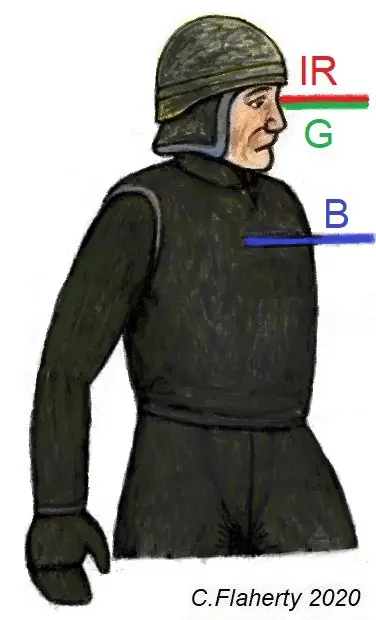
“FIGURE 4: The various Laser target points on a Human form.”
FIGURE 4 (IR-G): Shows the various Laser target points on a Human form. As stated earlier, one of the anticipated tactical dynamics instituted by the Laser weapon is a shift from centre-mass aiming to head-only. This is driven by the development of Counter-Optical Tactics, and a shift to Purposeful Blinding Tactic, using Infrared and Green -level weapons, which have now been successfully developed (discussed below).
FIGURE 4 (B): A Burn-Through Blue-Level Laser Pistol at its Laser point-of-impact will encounter Human flesh, where it is exposed. It will also need to contend with a variety of metals, ceramics, glasses, and fabric types covering the head and body, all of which will have different interactions with the Laser Beam. This area of development is likely to be dominated by a next generation of Frequency Shifting, and Multifrequency Laser Weapons, which have been projected for military use since 2005 (Bunker, 2008). It is also anticipated that various heat resistant materials are used to reduce, or counter Laser effects.
COUNTER-OPTICS (PURPOSEFUL BLINDING) TACTICS
Powerful Counter-Optical Laser weapons, rather than used for their intended purpose to disable opposing optical-range equipment, can be used unethically, “[to achieve]… purposeful blinding … [of the opponent]” (Bunker, 1997). Proliferation of Laser technology that could be used as Counter-Optical Tactics weapons was already identified at the start of the 1980s, when concerns were raised about the threat of Low-Energy Lasers to Human vision on the battlefield (Bacon, 1980; Morrison, 1985; 1987; Anderberg, 1988). By the early 1990s, advocates for a blinding Laser ban (Anderberg, 1992), led to it being enacted in international law. The Geneva Convention ban (discussed earlier) has been more recently undercut by a technological revolution that has created a more direct route for the development of the Laser Pistol.
Starting, around 2000, Laser Pointers as a criminal misuse of an off-the-shelf product, was replaced within a decade by a potential weaponization of industrial-use cutting Lasers. Hybridizing Laser componentry, and developing telescoping components using a series of adjustable lens to act as a Laser Beam Expander have been the first indicators of a new type of Laserarm, that fire a Burn-Through Bean at a much greater distance, and pose extreme threats to Human eyes. This will lead to a new Technology Shock were a Laserarms Regiment takes its debut on a future battlefield. Such scenarios are well known based on the fictional Krasnovian army warfare playbook:
“The Krasnovians are not inhibited by Western ethical constraints. Therefore, in pursuit of an operational edge, they can be expected to employ advanced weaponry which they obtain, such as Counter-Optical Lasers, without moral reservations.” (Bunker, 1997)
Incidents known from the Iran-Iraq War (1980-1988), suggest over a thousand Iranian soldiers were purposely blinded by Iraqi operated Soviet tank mounted Laser range finders (Bunker, 2008). Weapons technological shocks could have truly horrific sets of consequences; and a possible future scenario could be anticipated:
The opening stage of the battle sees the first use of an elite First Laserarms Regiment, armed with a variety of gun-like Laser Pistols. The troops fan far-ahead of the main army deeply penetrating the opposing army’s forward positions. Beam-Paths rake whole positions, sweeping the full three-dimensional battlespace, blinding and dazzling hundreds of enemy combatants, and disabling crewed armoured vehicles, and helicopter craft. Panic soon sets-in and enemy soldiers are ordered to evacuate, and overwhelming numbers of injured soldiers crowd forward bases. Along roads are seen lines of soldiers with bandaged eyes being led back. Immediately Social Media carries images of the devastation, and massive protests breakout worldwide, and brutal reprisals targeting citizens of the country that launched the Laser attacks occur in many countries. Combatants start leaving for dead tortured and mutilated Laserarmed soldiers as retaliation. Laser Pistols are internationally condemned as ‘weapons of mass destruction’, in desperation battlefield commanders are given direct access to tactical nuclear weapons to try to achieve some type of battlefield parity against the new Laserarmed army.
The scenario serves to illustrate the notion of a weapons technology shock that begins to reshape the conventional battlefield. The reshape occurs where increasing powerful current In-Service, and the Homemade Laser Pistols are either design for, or used (misused) in contravention of the Geneva Convention ban, where an opponent willing the ignore the ‘Laws of War’ (Bunker, 2008).
A Laserarms scenario involving a multiple gunmen assault, such as was seen in 2008 could have equally devastating results. In 2008, ten members of the extremist organisation – Lashkar-e-Taiba, carried out some twelve coordinated shooting and bombing attacks for four days across the city of Mumbai. The gunmen were primarily armed with the standard Russian AK-47 Assault Rifle. The same attack using Laserarms, given these weapons have much greater Beam-Path distances, and fire continuously, many more people – civilians, and Law Enforcement could be blinded and injured. The tactical description for such an event would shift from one characterised as multiple firearms shootings – a mass casualty event; to one characterised as a number of Laserarms being used to create an area effect, where there were mass casualties. The collective effect of the weapons would make these more akin in operation to a weapon of mass destruction.
MEDICAL AND PSYCHOLOGICAL ASPECTS
Laser wounds represent a unique set of medical and psychological problems, that have tactical implications. For instance, the fictional scenario combat between the Krasnovian army who indiscriminately ‘lase’ their opponents – the Bluefor,
“[who]… would be required to contend with large numbers of ‘blinded’ soldiers who would require medical attention and evacuation, placing further logistical strain on its combat effectiveness.” (Bunker, 1997)
Among the unique wounding are eye corneal and retinal damage largely caused by the Low-Energy Lasers, which also include thermal effects, and potential for photochemical changes in the eye (Bunker, 2008; 2008a). Rare combinations of charring and lacerations caused by the High-Energy Laser injuries have been anticipated to,
“require a far more complex medical response than ones produced by standard firearms.” (Bunker, 2008; 2008a)
Infrared Laser, have been identified as having a greater psychological impact, because damage to the eye can be taking place without initially even knowing that it is happening (Bunker, 2000a; 2008; 2008a). This could create a pervasive fear culture of Lasers,
“[the]… disruptive and destructive effects of Lasers may bring on psychological issues not only for the victims of such incidents but also for those who could become targets.” (Begert, 2008)
Laser weapons operating on the invisible spectrum for Humans, have been recognized as creating a new psychological component to combat dynamics:
“[The] … invisible threat with its especially frightening consequences could affect the willingness of troops to look towards the enemy and use weapons’ sights, and might stimulate conversion reactions of hysterical blindness as an expression of battle fatigue.” (Bunker, 2000a)
“Psychological issues prior to, during, or after a Laser incident may be accompanied by undue stress or performance inhibitions and, thus, have significant impact on mission accomplishment.” (Begert, 2008)
“Once personnel, both military and law enforcement, realize that utilizing magnifying optics or viewing the operational space with the naked eye can pose the risk of being injured or blinded, their mission performance could become degraded.” (Bunker, 2008; 2008a)
CONCLUSION
Development in the last five-years represents a new family of weapons, that have the potential to replace the existing family of Conventional Firearms. The new generation of Laser Pistols, beginning as a toy, leisure pursuit, sports, and then deadly weapon is now set to surpass the contemporary firearm, as did the cartridge surpass the muzzle-loader. The purpose of this paper has been to explore a new generation of Laser Pistols that have run in parallel development to the larger heavier Laser weapons designed for U.S. Navy ship’s defence (since 2014), and land combat, mounted on Stryker vehicles; that will see use from next year, in 2021. The new generation of Homemade Laser Pistols are largely being developed, by a variety of ‘Awesome Dudes’ (the author’s characterisation) uploaded on various YouTube channels. Taking advantage of the previous decade’s mass utilisation of Laser cutting tools, that have increased efficiency, power, and smallness. Raising ire and derision from a largely conservative defence science community, the real technological revolution implications are largely being missed. Such as, the mass-proliferation of a younger generation of citizen-scientists and engineering operating, and free-exchanging information and design concepts through-out social-media platforms. The phenomena represent a fundamental shift towards a design culture informed by science-fiction, trial-and-error creativity, and the ‘I like to build cool stuff’ thinking. Focused less on research and development and more on the hybridization, and repurposing of technology. In short,
“we can expect a trial and error process to take place as the capabilities Lasers offer become incrementally recognized” (Bunker, 2000a).
The arrival of a militarily usable Laser Pistol – capable of burning through Human flesh, will likely come from the suburbs of the U.S., and the technology dumping grounds in Africa. Taking advantage of an altogether different design culture; one that operates on mix-and-match experimentation, aimed at immediate use, ingenious sourcing (without regards to ownership, origin, or intellectual property rights), and repurposing and fabrication of technology; all combined with 3D design, and 3D printed components.
Individual martial arts training, and weapons handling proficiency, sits at the base of all warfare. A continuous drive to increase lethality at the individual level, requires a high degree of Conventional Firearms competency, understanding how the weapon works, its effective tactical use and its limitations; likewise Laser Pistol use requires the same knowledge base. This will require a new tactical language to be developed around use of the Laser Pistol. This ‘education’ process will become part of an active feed-back:
“As Lasers become more technologically advanced and hostile forces modify their tactics for enhanced results, current disruptive outcomes may worsen, causing greater possible injury or death.” (Begert, 2008)
It may well be that Laser Tag become the future Tactical-Battle labs training a next generation of warriors, as the scenarios and mind-set for a combat using Lasers is a natural nursery for a future combat methodology.
Arguably, if thought about as a direct replacement of the Conventional Firearm, a Laser Pistol replacing the M4 Carbine would likely need to Burn-Through Human flesh, and do this at the effective firing range of 500 meters: 1,650 feet (for the M4 Carbine). However, current developments in actual Laser Pistols have largely led to an altogether different type of battlefield. Namely, the highly problematic class of weapons specifically meant for use in Counter-Optics (Purposeful Blinding) Tactics. Presumably banned by the Geneva Convention, has nevertheless been identified as a likely tactic since the 1980s, and remains a pervasive threat to this day by an opponent who decides not to abide by the Convention, and is willing to commit war crimes to win. This not only relates to a military opponent, but more widely:
“Such a ban … is meaningless to criminal elements … entities involved in terrorism, drug trafficking and other ‘not war – not crime’ phenomena.” (Bunker, 2000a)
At the beginning of this paper, it was stated that the Laser Pistol will likely arrive on the conventional battlefield, and in the civil environment by the end of 2021, given its current rate of technological convergence and development. However, as a proposition this statement is somewhat a misnomer, as commercial Laser Pistol Sets are currently marketed for training, sport (Pentathlon and Laser Runs) and entertainment uses, such as Laser Tag. A variety of current In-Service, Laser Pistol Dazzlers and Blinding weapons, have been circulating since 2000. The best documented weapons being a series of small arms developed in China, for its military and Law Enforcement.
Historical transition from a Laserarm (misused off-the-shelf commercial Laser), to an Improvised Laser Weapon (Grey Assembled Military-Like Technology), and the Homemade Laser Pistol, which is essentially a technology hybridization, represent a growing military and domestic threat. Criminal, terrorist and extremist utilizing Laser Pistols, seeing these as a ‘conventional weapon’ before the military widely adopt Laser Weapon Devices (Bunker, 2008). In passing, the only bar on uptake is Laser Pistols to date, “[are]… too ‘out of the box’ … to fully understand or appreciate.” (Bunker, 2008) Effectively a new social phenomenon – the ‘Laser Kids (transformed from stone throwing kids)’ (MEMRI, 2006; Bunker, 2008), sourcing componentry for home-manufactured Laser Pistols, are driven to seek the apparent weapon advantages over Conventional Firearms. One significant trend driven by a largely science-fiction informed design culture has been the desire to build a Laser Pistol that looks like a gun. The same phenomenon has also possibly retarded the development of a hand-held Human portable Laser weapon that can Burn-Through Human flesh to the extent that the design impetus has been driven by the notion that a Laser Pistol has to perform in the exact same way that a Conventional Firearm does. The major trend-shift will be building a weapon based on a more radically different design trajectory, as an outgrowth of its inherently different weapon’s qualities, in comparison to a Conventional Firearm.
The shift in thinking will likely relate to the camouflaging of Laser Pistols. Chinese In-Service weapons are made to look like Conventional Firearms, in order to hide these in plain sight, so that within a grouping of soldiers, or Law Enforcement the ones carrying Laserarms cannot be readily identified, and when the weapon is used there is a certain degree of shock, and confusion inflicted on an opponent, as a tactical advantage, as they cannot tell ‘where the shot came from’. The exact same tactical shock, and confusion can be gained where the Homemade Laser Pistol does not resemble a Conventional Firearm at all. Current use of 3D-Modelling Software, and 3D-Printing to design and make the housing for the Laser componentry can be readily changed from producing a ‘pistol-gun like configuration’ to any shape or object – even an independent small flying drone. The future Homemade Laser Pistol could potentially have any shape or form to conceal its whereabouts; and as it makes no sound when fired, and its Beam-Path may be largely undetectable to the Human eye, this would achieve maximum tactical advantages; presenting a potentially greater battlefield, and domestic threat.
REFERENCES
- Anderberg, B. Wolbarsht, M.L. 1992 Laser Weapons: The Dawn of a New Military Age. New York: Plenum Press.
- Anderberg, B. 1988 The Low-Energy Laser Aimed at the Eye as a Potential Anti-Personnel Weapon. The RUSI Journal. Volume 133. Number 1 (Spring).
- Bacon, D.P. 1980 Battlefield Lasers: A New Problem with an Old Cure. Military Review (October).
- Begert, M. Campbell, L. Heal, S. 2008 Disruptive and Destructive Effects of Laser Illuminations. FBI Law Enforcement Bulletin. Volume 77. Number 4 (April).
- Bunker, J. 2008 Terrorists and Laser Weapons: An Emerging Threat. Studies in Conflict & Terrorism. Volume 31. Number 5. Routledge.
- Bunker, R.J. Lindsay, D. 2008a Laser Weapons. FBI Law Enforcement Bulletin. Volume 77. Number 4 (April).
- Bunker, R.J. 2000 Criminals and Laserarms: Counter-Optical Tactics. The Tactical Edge. Volume 18. Number 4 (Fall).
- Bunker, R.J. Lindsay, D. 2000a The Laser Threat to California Airborne Law Enforcement. The Journal of California Law Enforcement. Volume 34. Number 2.
- Bunker, R.J. 1999 Criminals and Laser Pointers: Tactical Concerns Over Emergent Laserarms. The Tactical Edge. Volume 17. Number 2 (Spring).
- Bunker, R.J. 1997 Counter-Optical Lasers and OPFOR. Red Trust Star. Publication Volume 30. Number 1 (January).
- Federation of American Scientists. 1998 Anti-Personnel Laser Weapons FAS Website (11 November).
- Geneva Convention. 1980 [-1995] Practice Relating to Rule 86. Blinding Laser Weapons: Protocol IV to the Convention on Certain Conventional Weapons.
- Global Security. Illustration of China’s Latest Blinding Laser Weapons. Center for the National Interest. Global Security Website.
- Hutson, M.S. Ma, X. 2007 Plasma and Cavitation Dynamics during Pulsed Laser Microsurgery in Vivo. Physics Review Letters. Volume 99. Number 15. Article 158104 (10 October).
- LASTEC [Laser Science & Technology Centre]. 2020 Laser Fence System (LFS). LASTEC Website.
- Lin, J. Singer. P.W. 2018 China’s Destructive Laser Rifle has a Half-Mile Range. Popular Science Website (5 July).
- Lindsay, D. Bunker, R.J. 1998 The Laser Threat to Airborne Law Enforcement: Part I. Air Beat. Volume 27. Number 7 (November-December).
- MEMRI [Middle East Media Research Institute]. 2006 Mujahideen Use Laser Pointers to Disrupt Fighter Jets. Islamist Website Monitor. Number 16 (31 October).
- Morrison, D.C. 1987 When Eyes Become the Targets. National Journal (4 March).
- Morrison, D.C. 1985 Laser Weapons Come Down to Earth: Their Targets Electronic and Human Eyes. High Technology (May).
- Roblin, S. 2018 China’s Laser Guns: Everything You Always Wanted to Know About Them. The National Interest Website (12 May).
- Rousseau, V. 1917 The Messiah of the Cylinder. Everybody’s Magazine (June-September).
- Clute, J. Langford, D. Nicholls, P. Sleight, G. (Editors). 2020 [-2017] Ray Gun. SFE (Encyclopedia of Science Fiction), Third Edition.
- Chen, S. 2018 China Brings Star Wars to Life with ‘Laser AK-47’ that Can Set Fire to Targets a Kilometre Away. South China Morning Post (1 July).
- South China Morning Post. 2018 Chinese ‘Star Wars’ Laser Gun Appears to Set Fire to Objects at a Distance. YouTube Channel.
- Spencer, M. 2020 Directed Energy Weapons: Playing with Quantum Fire. Air Power Development Centre. Commonwealth of Australia (January).
- Trevithick, J. 2018 No, China Hasn’t Built A Laser Assault Rifle That Can ‘Carbonize’ People. The Drive: The War Zone Website (July 3).
- UAVDACH, 2020 [-2018] China in Race for C-UAS Tech and Laser Weapons. UAVDACH Website.
- S. Government. Office of the Assistant Secretary of Defense. 1995 DOD Announces Policy on Blinding Lasers. Public Affairs News Release (1 September).
- Wasef, B. 2012 Lasers Make Modern Pentathlon More Modern. Wired Website (8 November).
- Yao, J. (Editor) 2015 In Pics: China’s Blinding Laser Weapons. China Military Online Website (12 September).
- YouTube Video. 2017. For Privacy Reasons Publication Details not Included.
- YouTube Video. 2018. For Privacy Reasons Publication Details not Included.
- YouTube Video. 2020. For Privacy Reasons Publication Details not Included.
- Zak, A. 2018 The Soviet Laser Space Pistol, Revealed. Popular Mechanics Website (14 June).
AUTHOR
Chris Flaherty authored the Terrorism Research Center’s report – Dangerous Minds (2012). He was the co-primary author, along with Robert J. Bunker of the book – Body Cavity Bombers: The New Martyrs (iUniverse, 2013). Two essays of his, from 2003 and 2010 were reprinted in the Terrorism Research Center’s book – Fifth Dimensional Operations (iUniverse, 2014). He recently contributed a book chapter – The Role of CCTV in Terrorist TTPs, edited by Dave Dilegge, Robert J. Bunker, John P. Sullivan, and Alma Keshavarz, the book – Blood and Concrete: 21st Century Conflict in Urban Centers and Megacities, a Small Wars Journal anthology, published on behalf of the Small Wars Foundation with Xlibris (2019).
Dr Chris Flaherty https://au.linkedin.com/in/drchrisflaherty

